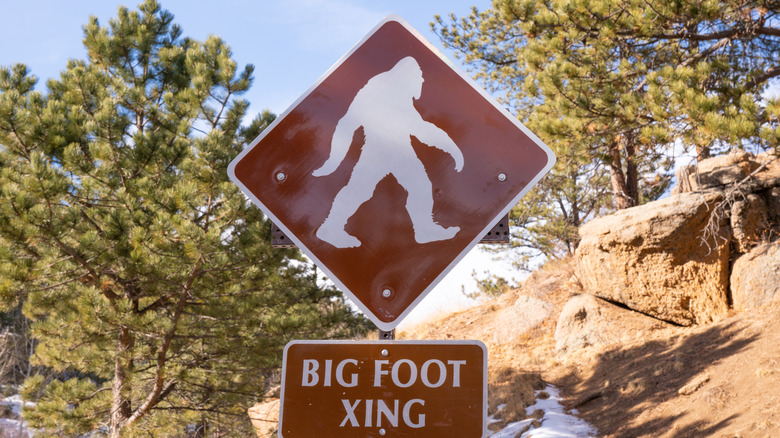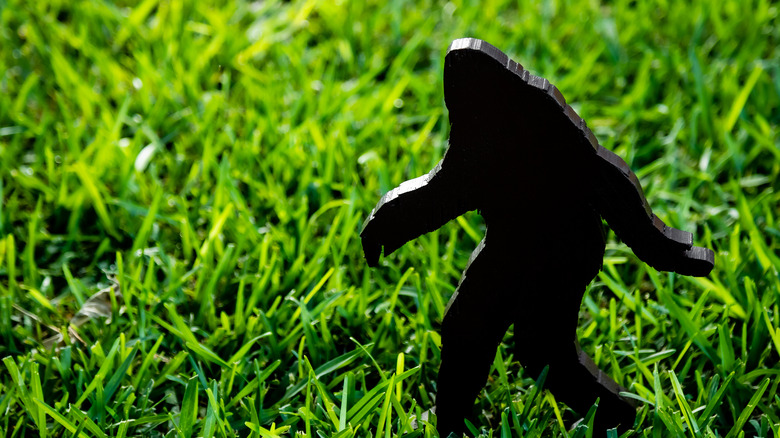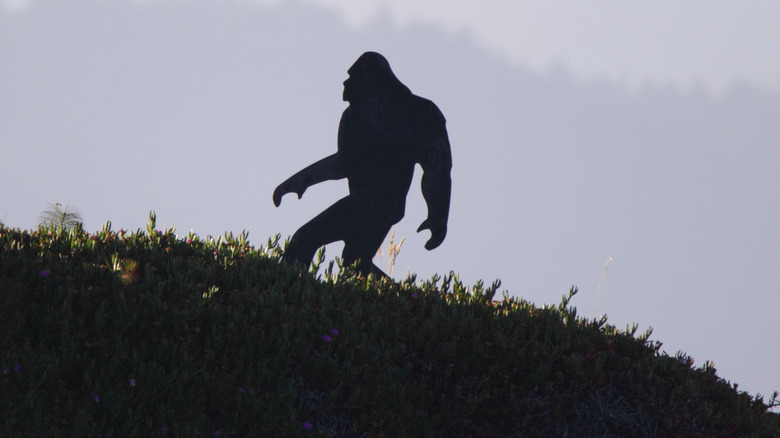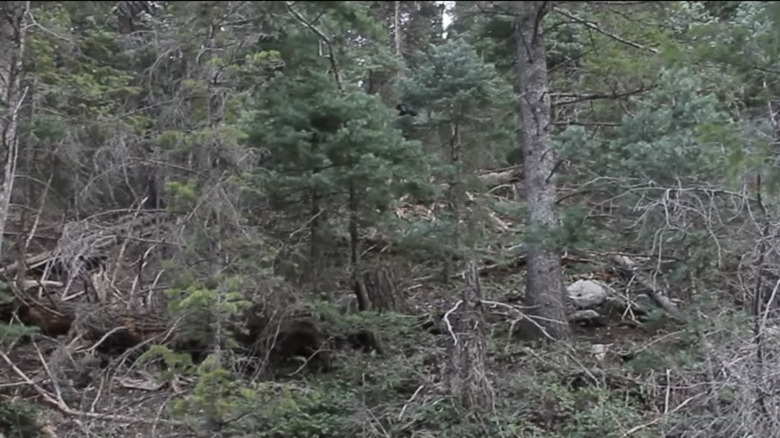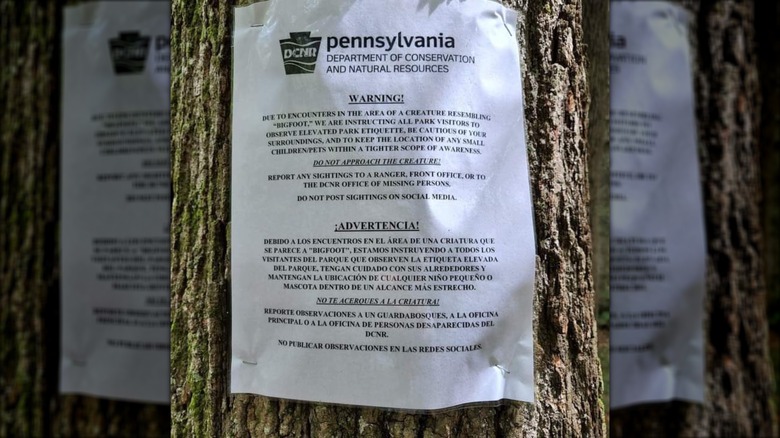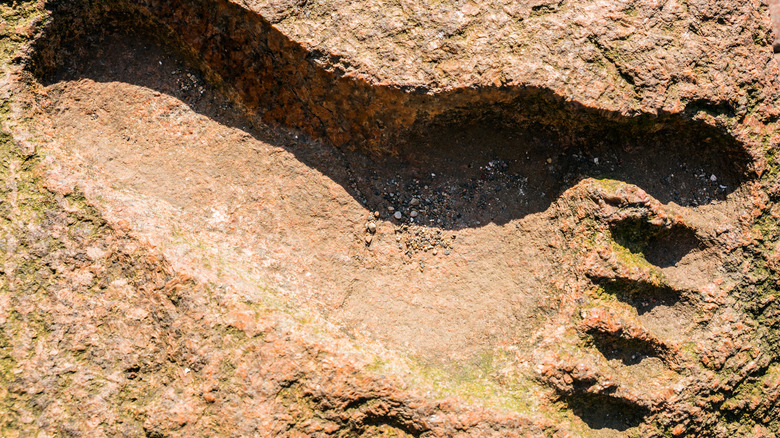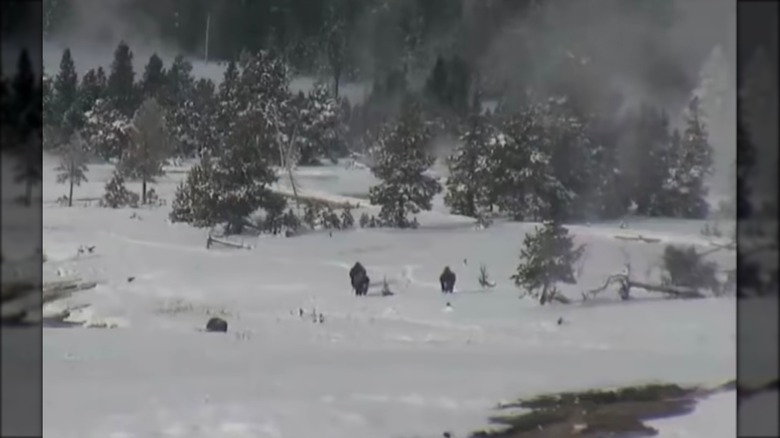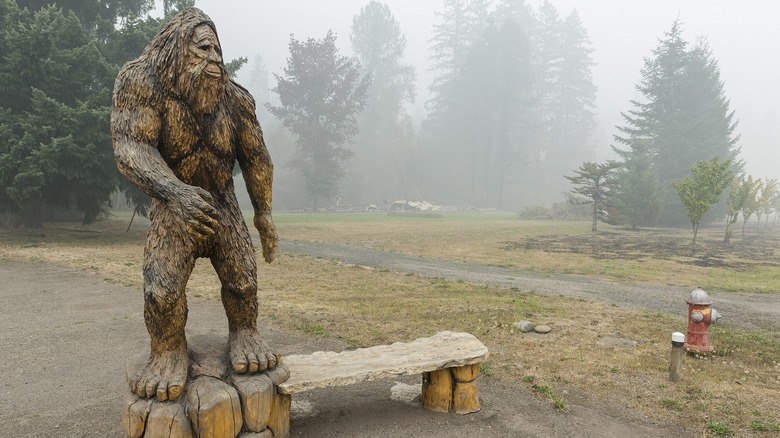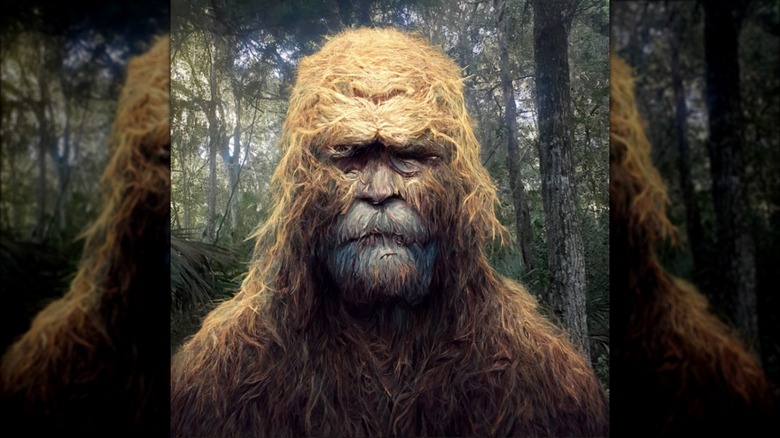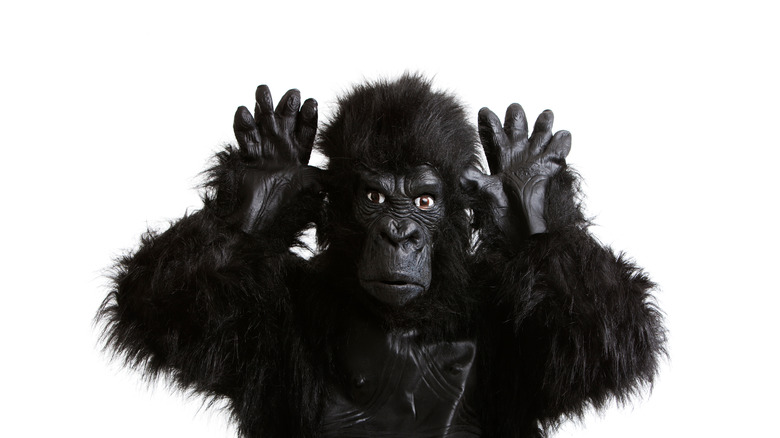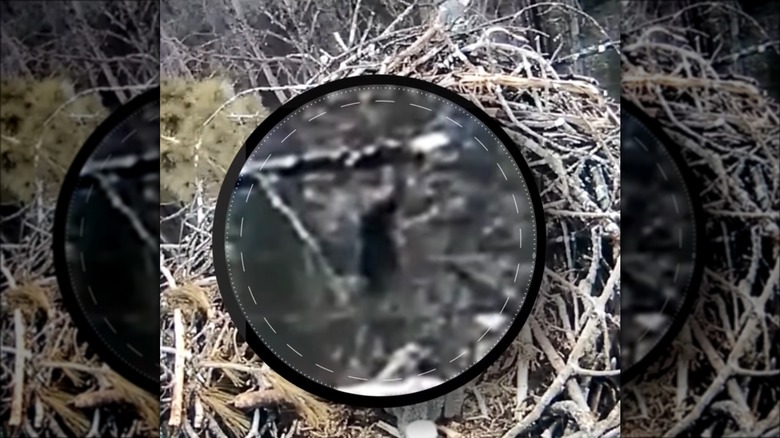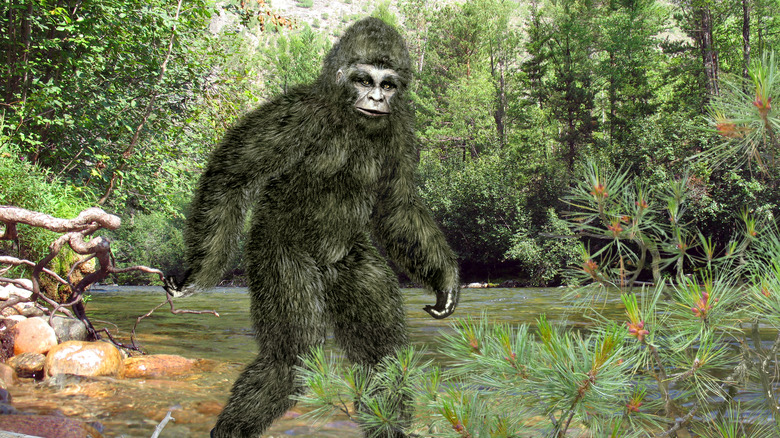The Most Unconvincing Bigfoot Sightings In History
A surprising number of people think Bigfoot actually exists. There's something thrilling and perhaps even comforting in the notion that our world is still big enough to contain mysterious creatures and myths come to life. For many, it's also big business. As Smithsonian Magazine notes, there is a veritable cottage industry of Bigfoot-related media that centers on this mysterious ape-like creature, from Animal Planet's "Finding Bigfoot" series to big-screen films like "Harry and the Hendersons." If none of this convinces you of the cultural power of Sasquatch, as the creature is often called, then visit a meeting of local investigators. Raise your doubts before representatives of a group such as the Bigfoot Research Organization and you may well bear the brunt of heated responses.
Still, as much as you may not want to be that person who's out to ruin everyone's good time, there are some issues with the idea of Bigfoot. As per Scientific American, evidence for this large-footed cryptid is inconsistent and can often be chalked up to misidentified animals and wishful thinking. If Bigfoot were real, the reasoning goes, we'd have a heck of a lot more evidence than blurry photos and some suspiciously neat footprints. Ultimately, the choice of whether or not to believe in Bigfoot is up to you. But if you're still a fence-sitter, some of these especially unconvincing sightings of Bigfoot may push you over to the skeptic side.
This Alabama Bigfoot sighting was a prank
Even before the truth about this particular Bigfoot sighting was revealed, the whole thing was hard to believe. In 2022, NBC 15 reported that a Bigfoot was allegedly sighted near a lake called Big Creek in Wilmer, Alabama. The photos captured by a man "while turkey hunting" in the area and posted on social media clearly showed a hairy, bipedal figure moving through the brush alongside the lake. The news went national, grabbing attention for what could be some of the clearest images of Sasquatch ever made.
But turns out, it wasn't Sasquatch at all. Local man Kenny Walker readily confessed to hoaxing the whole thing with his friend, Taylor. The duo had originally planned to make a TikTok for April Fools Day, but their busy schedules didn't allow that to happen. When Kenny finally got some time off, he went ahead with the post, even going so far as to claim that the Mobile County Sheriff was on the case. Apparently, the Sheriff's Department thought the joke was funny enough to let Walker off the hook.
Silly as the stunt may have been, Alabama has a history of Bigfoot sightings. In 2016, one man claimed that a Sasquatch was harassing his family in rural Clarke County (via AL.com). The Bigfoot Field Research Organization took the sightings seriously, though threats of killing the creature have so far failed to produce a body.
Bigfoot hair is often unconvincing
For many researchers, the holy grail of Sasquatch evidence would be a body. If someone could produce the remains of a large, non-human hominid that had been roaming the forests of North America, it would be a game-changer. Scientists could examine and test the remains to their heart's content, and finally, everyone would have to admit that Bigfoot is real. Only, that hasn't happened yet, as far as anyone can tell.
However, some field investigators have claimed that they possess something pretty close: Bigfoot's hair. The only problem? When samples are sent off to a legitimate lab for testing, the results can be disappointing. According to Science, researchers from Oxford and the Museum of Zoology in Lausanne, Switzerland began collecting purported Bigfoot hair samples. Of the 57 they received, 20 were either too old to analyze or weren't hair at all (some were fiber from manmade materials or plants). Seven didn't produce a good enough sample, while the 30 that did were all identifiable as regular old animals, including bears, canines, deer, and humans.
Even the FBI once devoted some lab time to analyzing supposed Bigfoot hair. According to History, the bureau received a sample in 1976. Even though the FBI typically stuck to criminal investigations, it made an exception for Peter Byrne, the then-director of Oregon's Bigfoot Information Center and Exhibition. Researchers found that Byrne's sample was simply deer hair, though the file on this investigation wasn't declassified until 2019.
A Utah Bigfoot is too blurry for its own good
Is Bigfoot roaming the canyons of Utah? Maybe, but more people are going to need a photography class or two before skeptics are convinced. Perhaps that's a bit unfair, as it can be difficult to get things like focus and light exposure just right under the best of circumstances. The sudden appearance of a potential cryptid certainly wouldn't give even an experienced nature photographer a lot of time to grab the right lens.
Even so, the footage of a supposed Bigfoot meandering through Utah's Payson Canyon isn't exactly a slam dunk. According to NBC4i, a video shot in the area shows an upright figure moving through the landscape for a mere three steps. The agonizingly short screen time already makes things tough to analyze, while the blurry resolution means it could be any number of things. Sure, it may really be a Sasquatch briefly glimpsed as it meanders through the trees. But it could also be another person wearing dark clothing and obscured behind branches, or even a prankster wearing a classic gorilla suit.
These Pennsylvania Bigfoot warnings were hoaxed
While this technically isn't a Bigfoot sighting, it certainly raised an alert for some hopefuls and earned the hoaxers extra points for originality. And all they needed was some paper, a printer, and the primed imaginations of others.
It all started in 2022 when a series of signs were posted in state parks throughout Pennsylvania. Per The Morning Call, the official-looking warning from the "Pennsylvania Department of Conservation and Natural Resources" cautioned visitors to keep an eye out for Sasquatch, which had been reportedly sighted in the area. The notices also urged anyone who may have sighted such a creature to report their encounter to a park official or the "DCNR Office of Missing Persons." Oh, and of course, no one was supposed to post anything about any encounters on social media.
Although the DCNR is a real Pennsylvania state agency, the notices were definitely fake. Officials stated that they took down the signs whenever they could, though it wasn't clear who was posting them or how many of the hoax notices were lurking in parks and on trails.
One prankster admitted to faking Sasquatch footprints
Some Bigfoot sightings are easy to dismiss. Out-of-focus photos could be just about anything, while even videos can be faked with careful staging and an appropriately hairy costume. But what about footprints? Those might be more compelling, especially since few, if any, humans have the sort of shoe size that can compete with the massive footprints found in the wake of the creature.
But, if one key confession is to be believed, footprints can be faked relatively easily. That's a potentially upsetting proposition for Bigfoot believers, as it can upend evidence that's been tantalizing people for decades. According to The New York Times, the evidence in question is a set of footprints found near a remote California logging site in 1958. After the discovery, the oversized tracks led to the term "Bigfoot." Since then, a proliferation of other tracks has convinced many, including a small group of academics, that Bigfoot is the real deal.
Too bad the original tracks were faked. The culprit? Ray L. Wallace, a known prankster who purportedly asked a friend to carve wooden feet, which he then stamped into the ground to make the prints. Wallace took the secret to his grave, and his children later revealed the truth. Long before then, however, some suspected that the fun-loving Wallace may have played into the legend as a lark.
Who's wandering in Yellowstone?
Yellowstone National Park is a pretty heavily trafficked place. In 2021, the National Park Service reported that it had experienced the busiest year in its history with more than 4.8 million people visiting the national park, which is largely based in Wyoming. But is it possible that all those tourists could have missed a Bigfoot or two roaming the wild reaches of Yellowstone?
Maybe, but some will have you believe that a providentially-placed webcam did catch the creature. In 2014, a video surfaced that supposedly showed four Sasquatches wandering through a snowy landscape near a group of bison, all caught on a park webcam (via ABC7). The footage spread throughout the Bigfoot research community, with many concluding that, blurry as it was, we had good evidence of the elusive hominid. Others were less convinced. In an interview with National Geographic, zoologist Michel Sartori argues that the footage — which was supposedly downloaded from a webcam and then uploaded to YouTube — could be digitally manipulated. Others have also argued that the figures may be regular humans on a hike.
This isn't the first time that general strangeness has been reported within the confines of Yellowstone. According to the National Park Service, the official park records contain no reports of Bigfoot, but there are weird tales of buzzing "lake music" heard on Lake Yellowstone.
A veterinarian's research fell flat
Authority can be a tricky thing. Someone who's put in years of research and training — and perhaps earned an advanced degree in the process — can reasonably claim to know more about their field than the average person. But an appeal to authority is a logical fallacy for a reason. Not everyone who appears to be an expert really knows what they're talking about.
Take Melba S. Ketchum. Sure, she's a veterinarian, but her Bigfoot research has come under intense scrutiny. First, there's the issue of how the samples in her 2012 study were managed. As NBC News reports, the 111 samples of possible Bigfoot DNA could have been contaminated in the field. The hominid DNA found by Ketchum in the samples may have been contributed by researchers who sneezed on it. Moreover, when the Houston Chronicle got a respected geneticist to independently test a sample, it turned out to be mostly opossum, with some other familiar species mixed in. Another awkward circumstance: Ketchum couldn't get the study past the rigorous peer review process, so she founded her own journal and published it there.
Geneticist Dr. Scott Disotell (via NBC News) also questioned Ketchum's claim that the Bigfoot DNA in her study split off from humans about 15,000 years ago. Given that humans have about 50,000 years of shared genetic history, it's all but impossible that a creature as dramatically different from us as Bigfoot would be so close to us on that evolutionary timeline.
One skunk ape witness stands to benefit from Bigfoot
Real or not, Bigfoot looms large in the modern imagination. The wily creature is everywhere — from craft beer to a starring role in a heartwarming family film opposite John Lithgow — except, that is, in front of a reliable witness with a good camera. Even so, places like Colorado's Sasquatch Outpost have a decent little business going based on local Bigfoot sightings. Down in Florida, that may seriously complicate one man's sighting of the elusive ape.
The creature in question is known as the skunk ape, so called because it's said to nearly knock you over with its stink in the already odiferous swamps of Florida. And the human who's come to attention as a self-made expert on the creature is Dave Shealy. As per Smithsonian Magazine, he claims to have seen the skunk ape at least three times, including a July 2000 encounter that he caught on film. Though Shealy adamantly denies any trickery, the blurry footage hasn't done much to convince anyone who isn't already a believer.
Then, there's the matter of the gift shop. According to Smithsonian Magazine, Shealy has a skunk ape-themed store and has made numerous media appearances as a skunk ape authority. It could be that Shealy is an honest man who believes that he's seen something strange lumbering through the Everglades. Yet, there's no denying that he stands to make a profit from the continued existence of the Florida skunk ape.
A Bigfoot body raised serious suspicion
For a moment in 2008, it seemed as if someone was about to produce final, irrevocable evidence of Bigfoot. As CNN reported at the time, Matthew Whitton and Rick Dyer said that they had procured a Sasquatch carcass. At over seven feet tall and over 500 pounds, it seemed it couldn't have been anything other than the once mythical creature, now made very real. The pair was cagey about where exactly they found the remains but released a photo of the body crammed into a freezer that seemed hard to deny. Bigfoot hunter Tom Biscardi was even called in to confirm the groundbreaking discovery.
It was all too good to be true ... literally. Soon enough, Reuters was reporting that the "body" was nothing more than a gorilla costume, that now-classic bugaboo of Bigfoot research. Researchers who had set about thawing the supposed remains eventually realized that the head was hollow. As the feet thawed, it became clear that they were rubbery.
Even worse, anyone who looked into Biscardi's background found that he was less than credible, as ABC News noted. Dr. Jeff Meldrum, an anthropology professor at Idaho State University and noted Bigfoot researcher, claimed that the trio's goings-on only undermined the real research he and other honest investigators were trying to undertake.
A prominent Sasquatch researcher is unimpressed with this sighting
With the proliferation of cameras throughout the world, you'd think we would have good evidence of Bigfoot by now if it exists. There are more and more people pushing into wild places, often carrying high-tech camera phones that could capture an elusive Sasquatch with little warning. Humans have also installed wildlife cameras in rural spots, looking out for animals such as nesting bald eagles. So, is it possible that one such camera setup caught a Bigfoot in Michigan?
Yet again, this blurry footage hasn't won too many believers over to the side of the Bigfoot faithful. As the Yakima Herald reports, the camera was focused on a nest of eaglets. The dark, bipedal figure strolling beneath them could be Bigfoot ... or it could also be a boring old human on a hike. Even Jeff Meldrum, one of the few academics who combines real research cred with belief in Sasquatch, couldn't bring himself to endorse this one. As he told the Yakima Herald, the clip lacked any real evidence one way or another. Chalk another one up to the unidentified and seriously unhelpful blobsquatches.
A key Bigfoot film remains deeply controversial
In the world of Bigfoot research, it's all but impossible to avoid the Patterson-Gimlin film. The 1967 film was shot by Bob Gimlin and Roger Patterson, who claim to have seen a female Bigfoot striding near Bluff Creek in rural Northern California (via Oregon Public Broadcasting). Though "Patty," as the creature is known, only appears on film for less than 60 seconds, she's seen by many as proof of Bigfoot's existence. Investigators say that her movement is too fluid and too natural to be anything but the real deal.
But is it really all that convincing? The Skeptical Inquirer goes so far as to call the whole thing a hoax. It notes that Clyde Reinke, an office manager for a film company, said that his employer and Patterson planned the hoax to draw audiences into theaters. Another man, Bob Heironimus, claimed that he played Patty. Yet another person, costumer Philip Morris, says he and his wife created the getup.
This could all be hearsay, but there are some quirks in the film itself. For example, a telltale "fur line" could just be the costume's zipper. Moreover, the feet are oddly shaped, with one appearing to have an arch on the outside of the foot — contrary to the many casts collected in the area. For some, these quirks can all be explained away, but others just can't put their faith in this infamous film.
